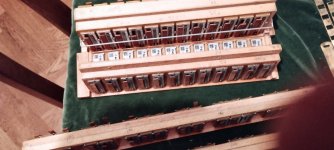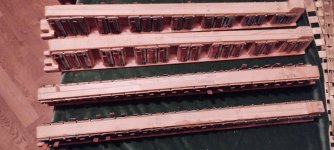warmday
Newbie
Hello you founts of knowledge. I need some advice to help me complete the restoration of a Hohner Tango V (circa 1938-40)
41 keys F1 – A6
120 bass
2 x palm switches
1 x bass switch
I'm in the middle of restoring this lovely instrument and I have completed all the mechanical work but I need to know which reeds to tune to A440 and which others to tune sharp/flat for the musette. The configuration of the reeds in the blocks has me baffled.
4 x treble reed blocks:
1. F#1 - G#4 one side and F#2 - G#5 other side (i.e. 8ves on chromatic notes)
2. F#3 - F#4 on both sides (unison on chromatic notes)
3. F2/3 – A5/6 on both sides (unison diatonic 8ves)
4. F3 – A6 on both sides (unison diatonic)
2 x bass reed blocks:
1. G0 - F#1 side 1 and G1 - F#2 side 2 (8ves)
2. G3 - F#4 side 1, G4/5 - F#5/6 side 2 and A4/5 - F#5/6 on 3rd side (at right angles to sides 1 & 2)
Some pics of the reed blocks are attached.
I have tuned pianos before, but never an accordion, although I understand the principals.
If you could give me a clue as to which reeds to tune to what, I would be most grateful.
Kind regards

David
41 keys F1 – A6
120 bass
2 x palm switches
1 x bass switch
I'm in the middle of restoring this lovely instrument and I have completed all the mechanical work but I need to know which reeds to tune to A440 and which others to tune sharp/flat for the musette. The configuration of the reeds in the blocks has me baffled.
4 x treble reed blocks:
1. F#1 - G#4 one side and F#2 - G#5 other side (i.e. 8ves on chromatic notes)
2. F#3 - F#4 on both sides (unison on chromatic notes)
3. F2/3 – A5/6 on both sides (unison diatonic 8ves)
4. F3 – A6 on both sides (unison diatonic)
2 x bass reed blocks:
1. G0 - F#1 side 1 and G1 - F#2 side 2 (8ves)
2. G3 - F#4 side 1, G4/5 - F#5/6 side 2 and A4/5 - F#5/6 on 3rd side (at right angles to sides 1 & 2)
Some pics of the reed blocks are attached.
I have tuned pianos before, but never an accordion, although I understand the principals.
If you could give me a clue as to which reeds to tune to what, I would be most grateful.
Kind regards


David
